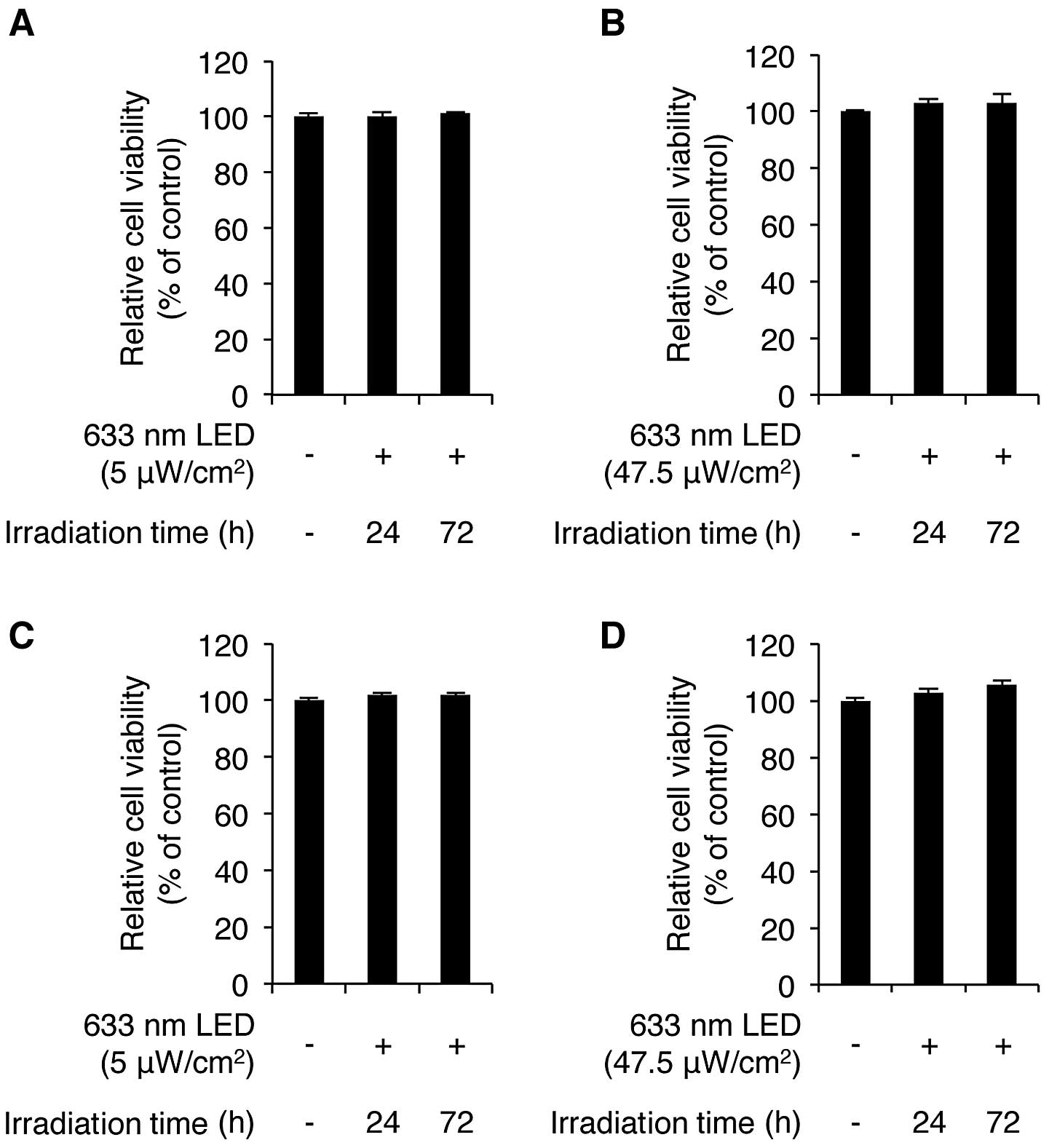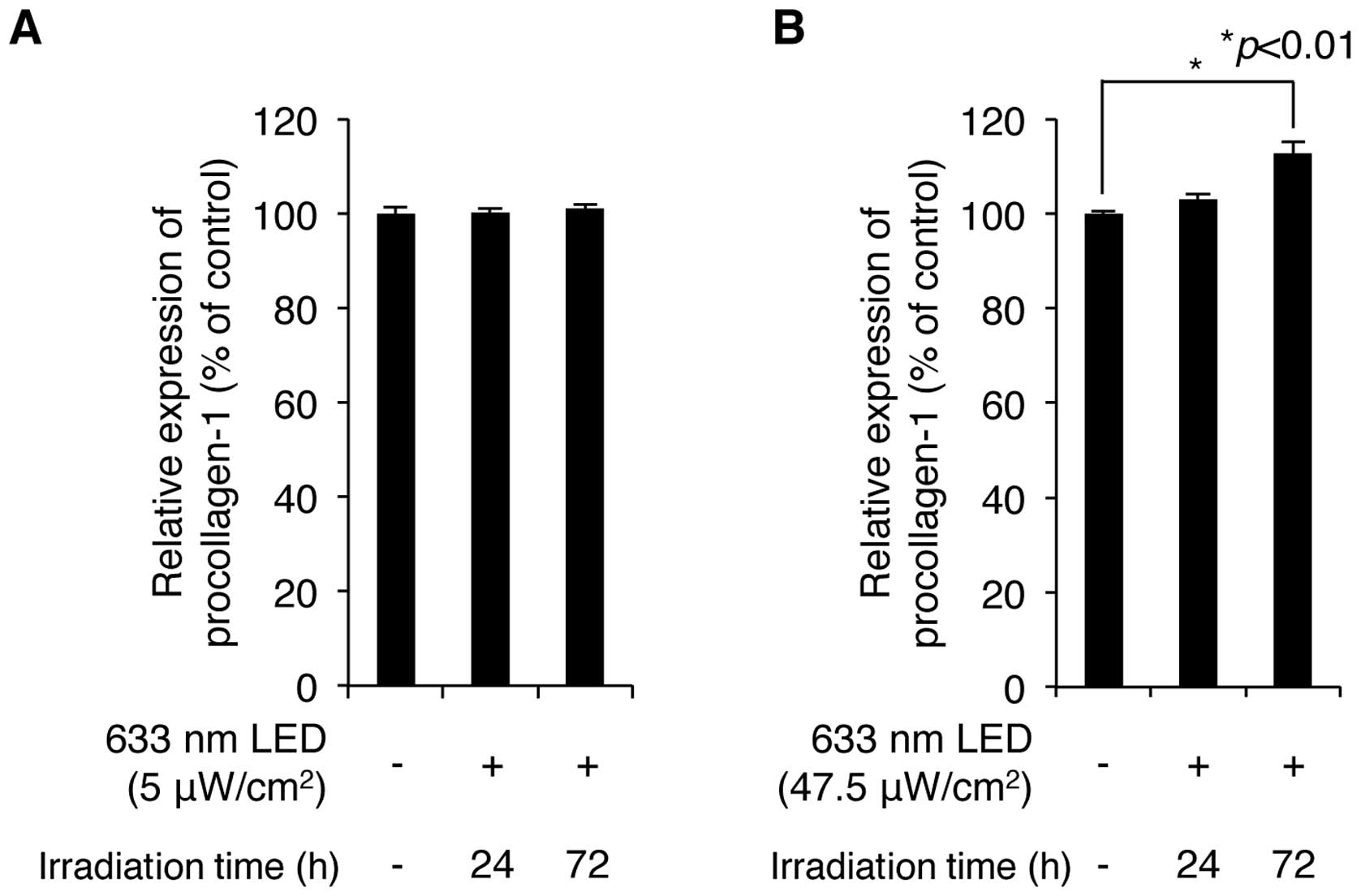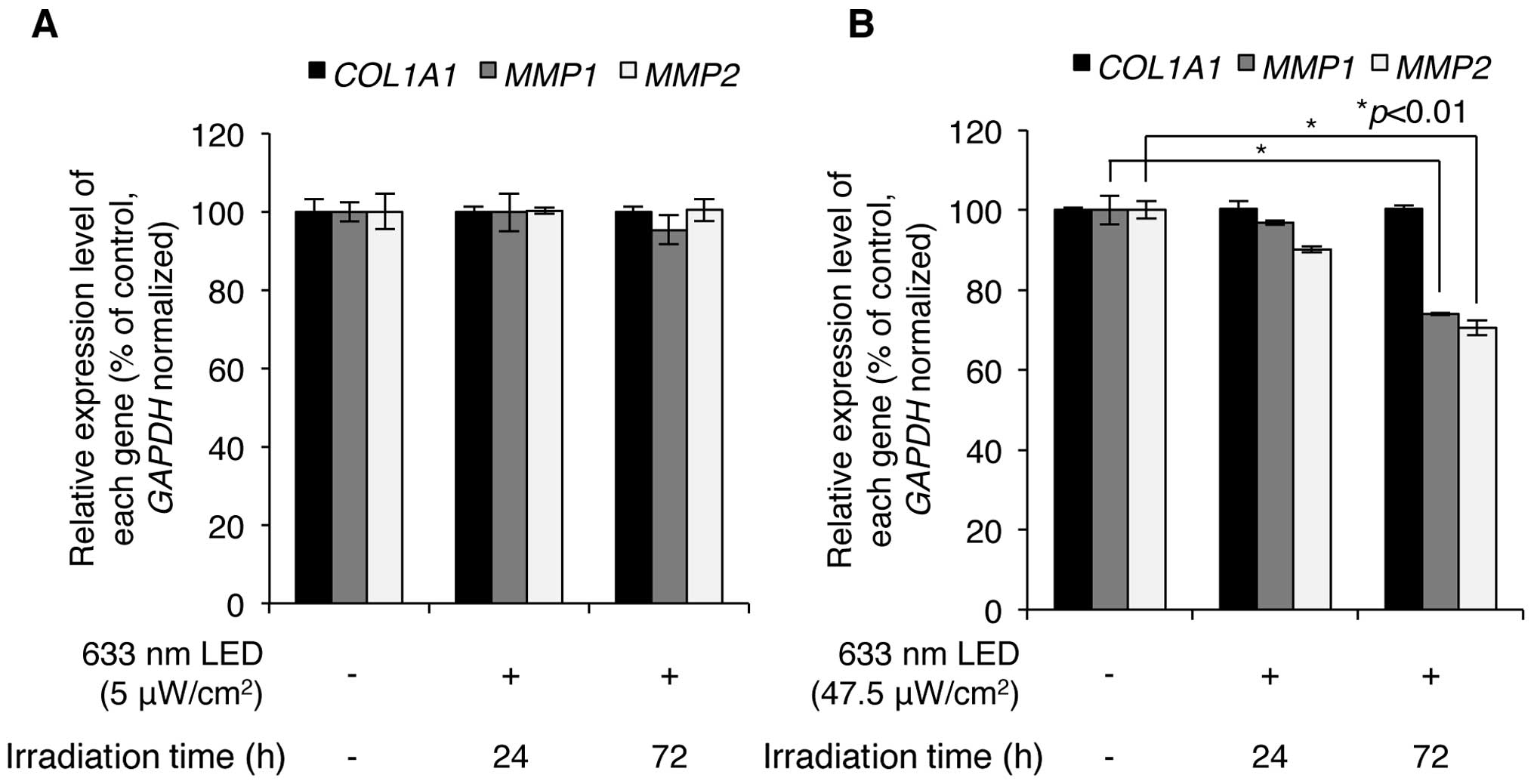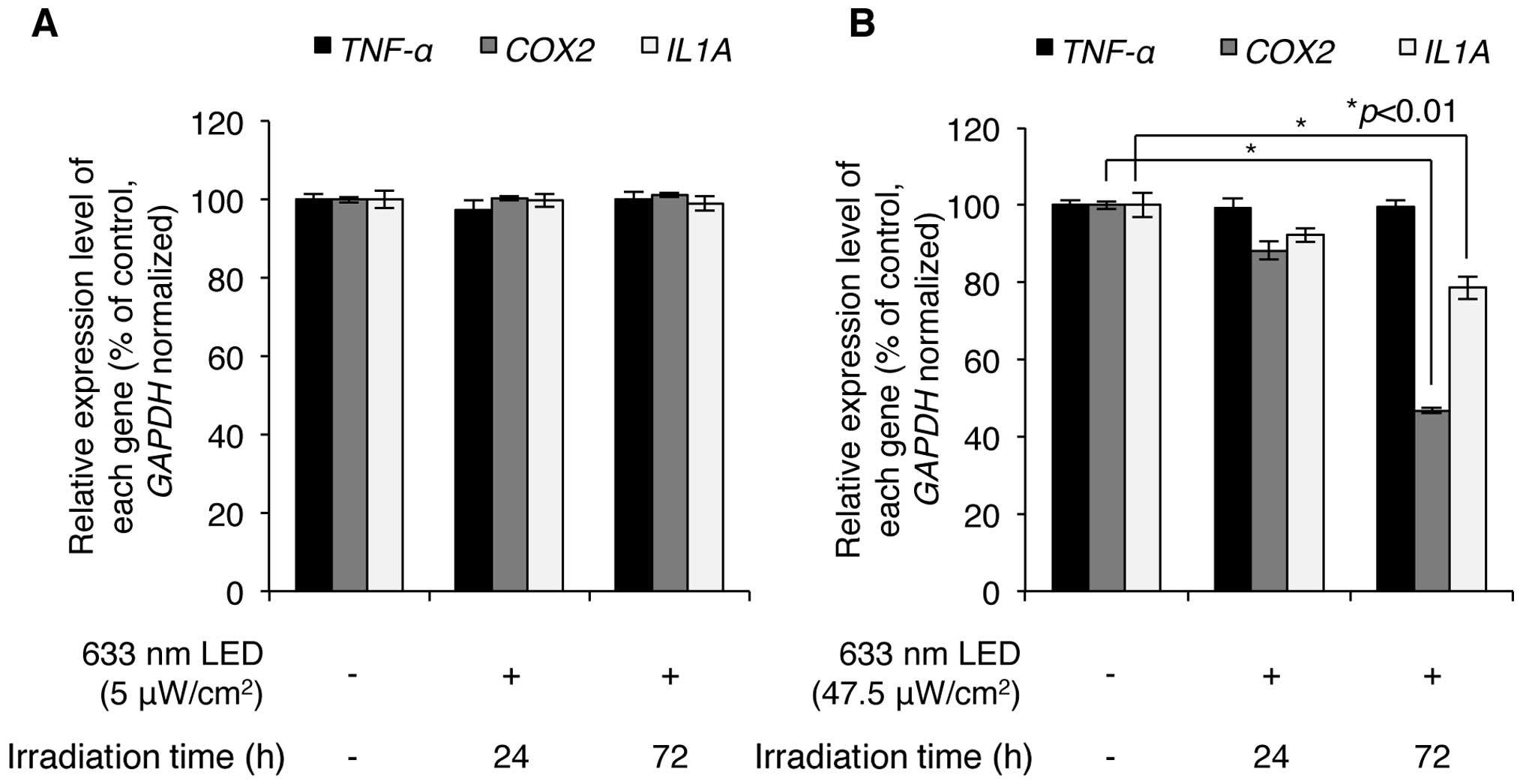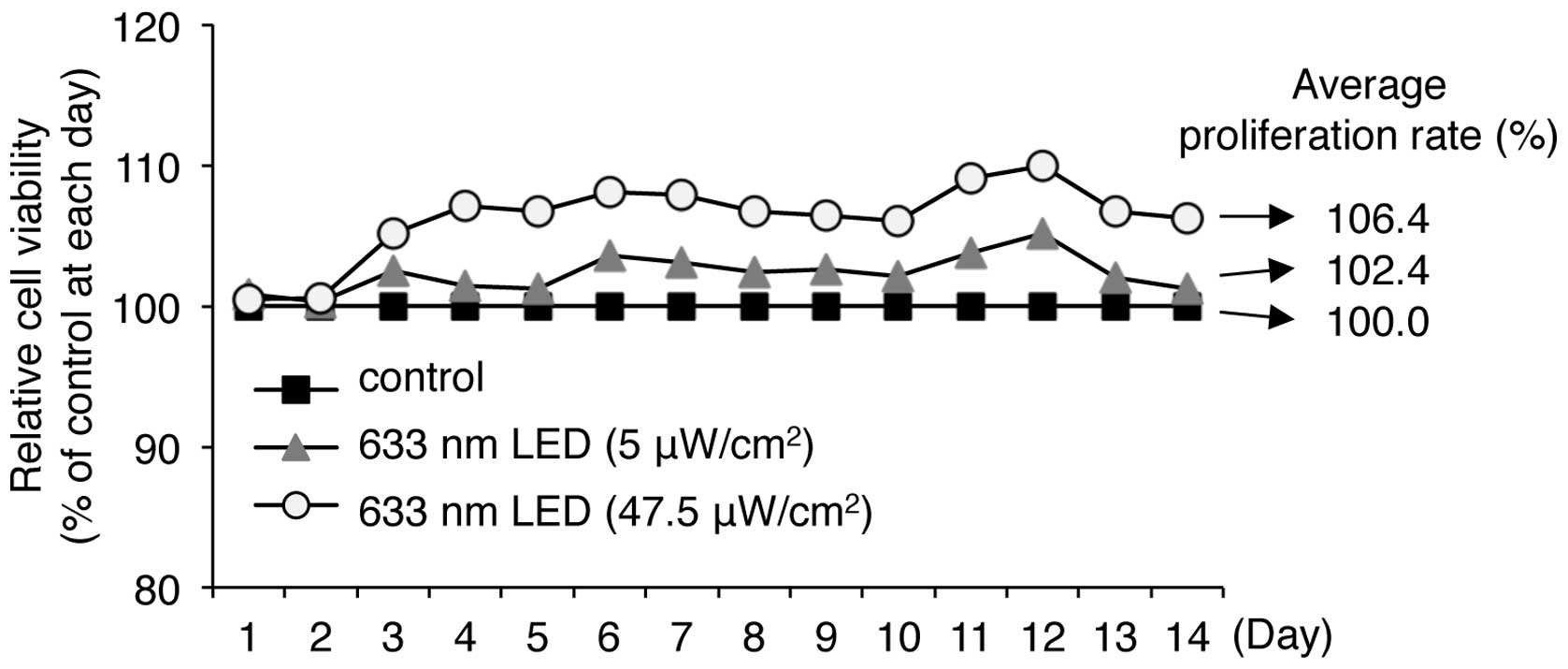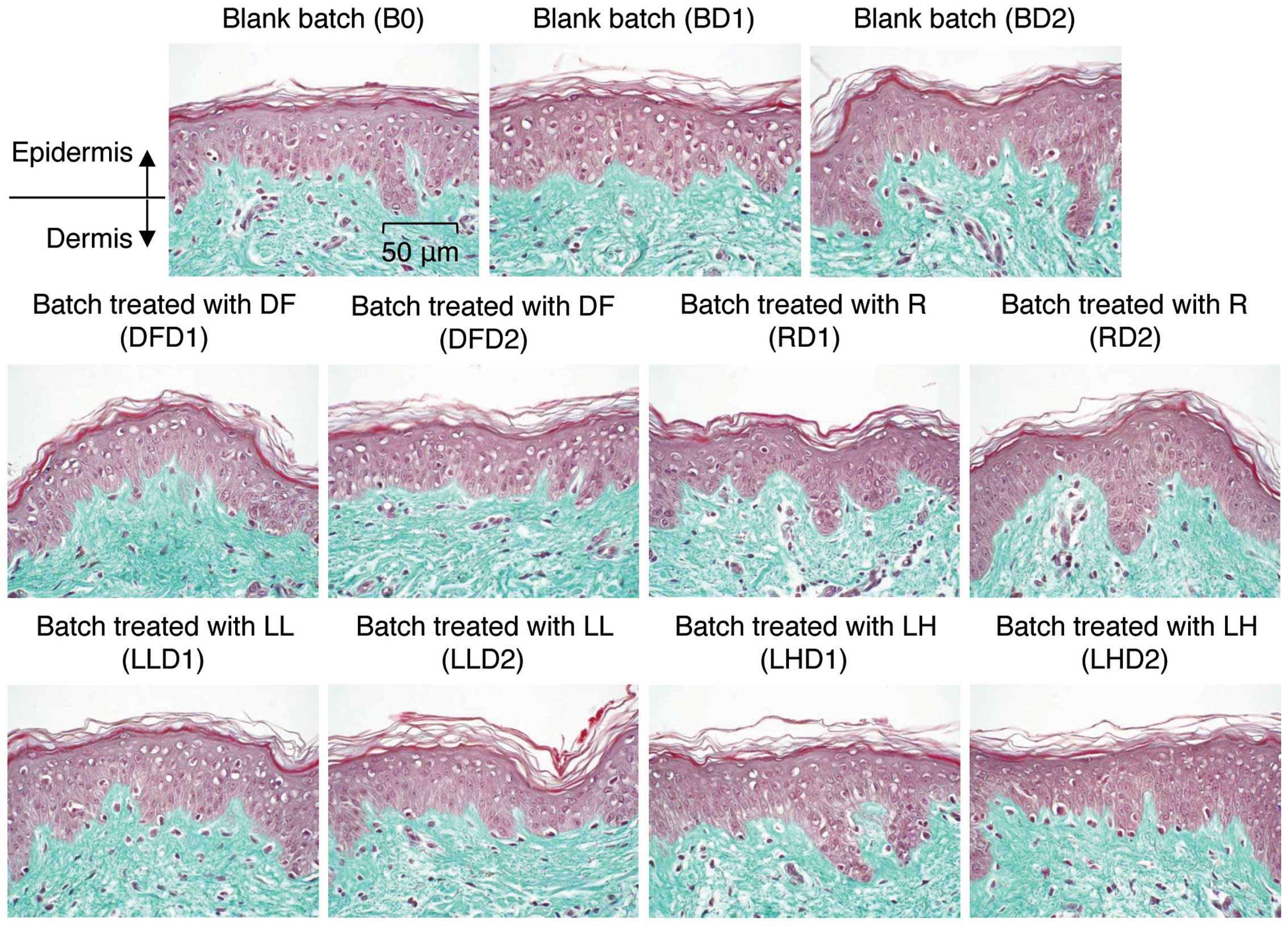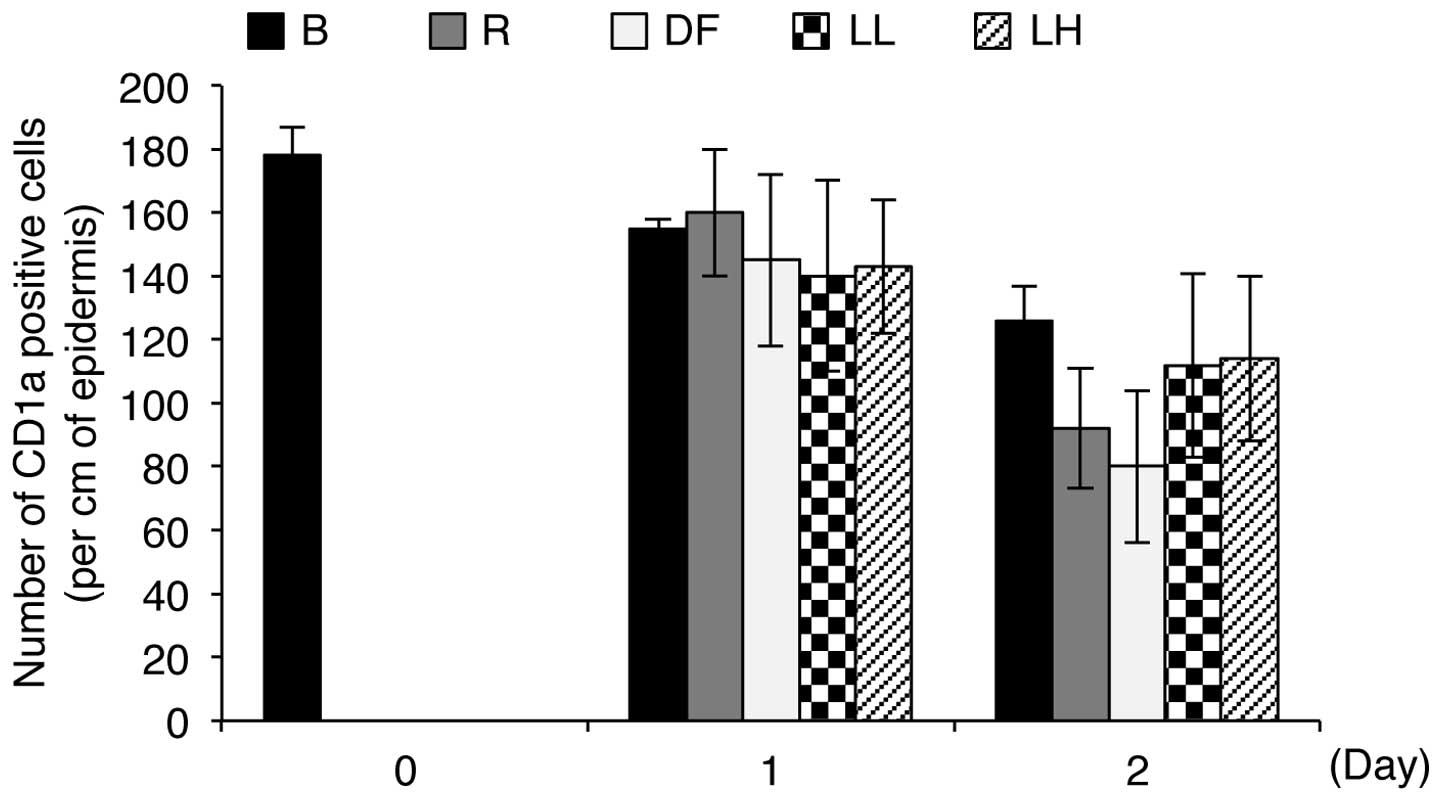Continuous irradiation with a 633-nm light-emitting diode exerts an anti-aging effect on human skin cells
- Authors:
- Published online on: December 9, 2014 https://doi.org/10.3892/ijmm.2014.2030
- Pages: 383-390
Abstract
Introduction
As the aging population continuously increases, the age-related dermatological concerns are continuously addressed by the cosmetic and medical industries (1). Skin aging is a multisystem degenerative process, which is characterized by the loss of structural integrity and physiological function by both intrinsic and extrinsic determinants (2). Intrinsic skin aging is caused by genetic determinants; therefore, this mechanism is an inevitable natural consequence of physiological changes in the absence of altered genetic information (3). Extrinsic skin aging, on the other hand, is caused by extracellular factors, such as ultraviolet radiation, pollutants and nicotine; therefore, this type of aging is controllable as individuals can avoid these age-inducing factors (3). Among the signs of skin aging, wrinkling is the primary characteristic, which is induced by decreasing collagen and increasing collagenase production (4). Collagen, which is the most abundant protein in connective tissue in mammals, contributes to firmness and is thus vital for skin elasticity. The most common type of collagen in the skin is type 1 collagen, which comprises >90% of the collagen in the body (5). Type 1 collagen is composed of two α1(I) chains and one α2(I) chain, which are encoded by the COL1A1 and COL1A2 genes, respectively (5). The synthesis of type 1 collagen is transcriptionally regulated in skin fibroblast cells, and UV-induced photoaging involves the downregulation of COL1A1 and COL1A2 and the consequent loss of collagen that induces fine wrinkles. In addition, the level of collagen is regulated by its proteolytic enzymes, matrix metalloproteinases (MMPs). Studies have demonstrated that skin aging induced by UV exposure is mediated by the upregulation of MMP1 expression (6,24). Therefore, several cosmetic products, including epigallocatechin-3-gallate (EGCG), exert their anti-aging effects through the upregulation of collagen synthesis and the downregulation of MMPs in skin fibroblasts (7).
In addition to the application of phytochemicals as potential anti-aging agents, several light sources have been investigated for their anti-aging effects on skin cells and tissues. Intense pulsed light (IPL) at wavelengths between 570 and 615 nm have proven to be an effective treatment for refractory melasma in Asian patients with minimal side-effects (8). In addition Moreover, 530-nm IPL may improve inflammatory acne through the downregulation of tumor necrosis factor-α (TNF-α) (9). Furthermore, studies have demonstrated that light-emitting diode (LED) irradiation at wavelengths of 590, 630, 633 and 660 nm is effective in photorejuvenation in vitro and in clinical studies in vivo (10–15). Following irradiation with a 590-nm LED, type 1 collagen levels have been shown to increase, while MMP1 levels have been shown to decrease (12). In a previous study, irradiation with a 660-nm LED was found to modulate the levels of type 1 procollagen and MMP1 by 31 and -18%, respectively (10). In another study, the irradiation of fibroblasts with a combination of a 630- and 830-nm LED or a 660- and 850-nm LED also increased collagen levels (14). These clinical and in vitro studies, however, examined the effects of single or interval LED irradiation, as opposed to continuous LED irradiation. Of note, to the best of our knowledge, the effects of continuous LED irradiation on skin cells and tissues have not yet been thoroughly investigated. To overcome experimental limitations, we manufactured a new cell culture incubator containing a 633-nm LED device and used this equipment to investigate the effects of continuous LED irradiation on skin fibroblasts and keratinocytes. Furthermore, for confirmation of the effects of continuous LED irradiation on human skin tissue, we cultured human skin explants in the LED incubator. We also investigated the safety of continuous LED irradiation at 633 nm by examining the levels of inflammatory genes in vitro and the migration rate of Langerhans cells to the dermis in tissues.
Materials and methods
Cell lines and chemicals
CCD-986sk normal human skin fibroblasts and HaCaT keratinocytes were purchased from the American Type Culture Collection (ATCC; Manassas, VA, USA) and Cell Lines Service (DKFZ, Eppelheim, Germany), respectively. The CCD-986sk and HaCaT cells were grown in Dulbecco’s modified Eagle’s medium (DMEM supplemented with 10% fetal bovine serum, 100 U/ml penicillin and 100 μg/ml streptomycin (all from Gibco Life Technologies, Grand Island, NY, USA). The 1-chloro-2,4-dinitrobenzene (DNCB) and the Dermatophagoides farinae body extract, which are agents used to induce an allergic reaction, were purchased from Sigma-Aldrich (St. Louis, MO, USA) and Biostir Inc. (Kobe, Japan), respectively.
Light source
The LED device, which emits a 633-nm wavelength, was provided by Samsung Electronics Co., Ltd. (Seoul, Korea). The spectral characteristics of the LED device were as follows: the peak wavelength was 633±3 nm and the full width at half maximum was approximately 20 nm. The effective irradiance values on the cell plates were adjusted to be 5 and 47.5 μW/cm2. For comparison, lighting devices with organic LEDs with the same spectral characteristics were prepared. Due to the high humidity (almost 100%) in the cell culture incubator, we sprayed a silicone varnish on the lighting devices to provide waterproofing and insulation. Cells subjected to no irradiation were used as controls.
Cell viability assay
The cytotoxic effects of the LED lights on the CCD-986sk and HaCaT cells were evaluated using a water-soluble tetrazolium salt (WST-1) assay (EZ-Cytox Cell Viability Assay kit; Itsbio, Seoul, Korea). WST-1 solution (1/10 culture medium volume) was added to the cultures, and the cells were incubated at 37°C for 0.5 h. Cell viability was determined according to the absorbance at 450 nm using an iMark™ microplate reader (Bio-Rad, Hercules, CA, USA). All results are presented as the mean percentage ± standard deviation (SD) of 3 independent experiments.
Enzyme-linked immunosorbent assay (ELISA) for procollagen type I
The ELISA assay for procollagen type 1 was performed using the Procollagen Type I C-Peptide (PIP) EIA kit (Clontech Laboratories Inc./Takara Bio Inc., Otsu, Japan) according to the manufacturer’s instructions. Briefly, the CCD-986sk cells were irradiated with a low (5 μW/cm2) and high (47.5 μW/cm2) intensity LED for 24 and 72 h. Following irradiation, the cell supernatants were collected. The antibody-peroxidase (POD) conjugate solution (Clontech Laboratories Inc./Takara Bio Inc.) was transferred to a well of an anti-PIP monoclonal antibody-coated plate (Clontech Laboratories Inc./Takara Bio Inc.), and the supernatant was subsequently added. The mixed samples were incubated. After discarding the well contents, the wells were washed with wash buffer (Clontech Laboratories Inc./Takara Bio Inc.). Substrate solution (Clontech Laboratories Inc./Takara Bio Inc.) was then added to each well, and the plates were incubated at room temperature for 15 min. Stop solution (Clontech Laboratories Inc./Takara Bio Inc.) was added, and the absorbance at 450 nm was measured using an iMark microplate reader. All results are presented as the mean percentage ± standard deviation (SD) of 3 independent experiments. A p-value <0.01, as determined by the Student’s t-test, was considered to indicate a statistically significant difference.
Isolation of total RNA and quantitative reverse transcription PCR (RT-qPCR)
After 24 and 72 h of irradiation, total RNA was isolated using TRIzol reagent (Life Technologies) according to the manufacturer’s instructions. The purity and concentration of the RNA was evaluated based on the optical density (OD) at 260 nm and the OD 260/230 and 260/280 ratios using MaestroNano®, a micro-volume spectrophotometer (Maestrogen, Las Vegas, NV, USA). cDNA was then synthesized using a SuperScript® III First-Strand Synthesis System for RT-PCR (Life Technologies). Quantitative (real-time) PCR was performed using SYBR®-Green PCR Master Mix and the SYBR®-Green RT-PCR Reagents kit (Life Technologies) and analyzed using Line-Gene K software (Bioer Technology Co. Ltd., Hangzhou, China). The CT value for each gene was normalized to GAPDH. The 2−ΔΔCT method was used to calculate the relative expression levels of each gene. The primers used for RT-qPCR are presented in Table I.
Human skin explant-based assay
For analysis of the safety of low (5 μW/cm2) and high (47.5 μW/cm2) intensity LED irradiation on human skin, we utilized the expertise of BIO-EC Laboratory (Longjumeau, France). Prior to this study, the BIO-EC Laboratory submitted these procedures to the Ethics Committee for the appropriate French geographic sector (Hôpital du Kremelin-Bicêtre, Le Kremelin Bicêtre, France) via the website of the French Ministry of Health. Furthermore, BIO-EC had previously developed a professional relationship with clinics and hospitals and was thus allowed to use human skin explants that were not specifically excised for experimentation in accordance with all applicable ethical principles.
A total of 33 human skin explants obtained from an abdominoplasty from a 45-year-old female were used. The diameter of each explant was ~10 mm. The explants were preserved in BEM medium (BIO-EC’s Explant Medium batch 060208) at 37°C in a moist atmosphere containing 5% CO2 for 12 h before the study was initiated. The DNCB solution (0.0062%) and the Dermatophagoides farinae body extract (10 mg/cm2) were applied topically to each explant for 1 or 2 days. Other skin explants were irradiated with low (5 μW/cm2) and high (47.5 μW/cm2) intensity LED for 1 or 2 days. After the 1- or 2-day applications, the skin explants were fixed in Bouin’s solution (30% formaldehyde, 5% acetic acid, 4% methyl-alcohol and 1% picric acid; BIO-EC Laboratory). Subsequently, a dehydration and impregnation process was used for the processing of the explants. During this process, water was progressively removed and replaced with ethanol using a 70% ethanol solution followed by a 95% ethanol solution. Ethanol was then replaced by butanol, and the explants were finally immersed in a bath containing paraffin at 56°C. This 3-day process included 3 baths of 70% ethanol, 3 baths of 95% ethanol, 5 baths of butanol and 2 baths of paraffin. After the preparation, the explants were placed in blocks with a Leica EG 1160 coating station (Leica Microsystems, Nussloch, Germany), and 5-μm-thick slices were prepared using a Minot-type microtome (Leica 2125; Leica Microsystems) and pressed onto superfrosted silanized glass slides. Microscopic observations were performed using an optical microscope (Leica-type DLMB microscope; Leica Microsystems) with a x20 objective. Photomicrographs were performed captured with a CCD Sony DXC-390P camera (Sony, Tokio Tokyo, Japan) and stored with Leica IM1000 data archiving software (Leica Microsystems). The observations of general morphology were performed on paraffin slices dyed with Masson’s trichrome, Goldner variant. As this study resulted in only observational and descriptive data, no statistical analysis was appropriate or feasible.
Analysis of CD1a-positive Langerhans cells
The DNCB solution (0.0062%), the Dermatophagoides farinae body extract (10 mg/cm2), and low (5 μW/cm2) and high (47.5 μW/cm2) intensity LED irradiation were applied topically to each explant for 1 or 2 days as described above. After the samples were fixed and paraffinized, the sections were immunostained using anti-CD1a 1gG antibody (Cat, no. sc-5265; Santa Cruz Biotechnology, Santa Cruz, CA, USA). The CD1a-positive cells were enumerated lengthways for each explant, and the number was extrapolated to the epidermic length in centimeters.
Results
Characterization of LED-induced cytotoxicity in human skin fibroblasts and keratinocytes
We first sought to determine whether LED irradiation at a wavelength of 633 nm affects the viability of human skin cells. CCD-986sk normal human skin fibroblasts and HaCaT keratinocytes were irradiated with low (5 μW/cm2) and high (47.5 μW/cm2) intensity LED at 633 nm for 24 and 72 h. As shown in Fig. 1A, the exposure of the CCD-986sk cells to low intensity LED irradiation for 24 and 72 h induced no cytotoxicity, according to the results of the WST-1 assay. We also found that high intensity LED irradiation did not cause any cytotoxicity to these cells (Fig. 1B). We then examined the LED-mediated cytotoxic effects on human HaCaT keratinocytes. The HaCaT cells were irradiated with low and high intensity LED at 633 nm for 24 and 72 h. LED irradiation-mediated cytotoxicity was not observed in the HaCaT cells irradiated with low and high intensity LED (Fig. 1C and D). Of note, both low and high intensity LED irradiation slightly increased the viability of the HaCaT cells. More specifically, high intensity LED irradiation for 24 and 72 h increased the viability of the cells to 102.9±1.2% and 105.7±1.3% of the control value (n=3), respectively. These results demonstrate that 633-nm LED irradiation does not induce any cytotoxic effects on CCD-986sk human skin fibroblasts and HaCaT keratinocytes.
Characterization of the LED irradiation-induced production of procollagen in human skin fibroblasts
We then examined whether irradiation with a 633-nm LED increases the production of procollagen type 1, which is synthesized and secreted by skin fibroblasts and provides strength and elasticity in skin tissue. CCD-986sk normal human skin fibroblasts were exposed to low and high intensity 633-nm LED irradiation for 24 and 72 h. The levels of procollagen type 1 in the cultured cell supernatants were analyzed by ELISA using a procollagen type 1-specific antibody. The exposure of the cell cultures to LED irradiation ranging from 5 to 47.5 μW/cm2 for 24 and 72 h increased the production of procollagen type 1 in an intensity-and exposure time-dependent manner (Fig. 2A and B). Although LED irradiation at 5 μW/cm2 slightly increased the production of procollagen type 1, maximal production was obtained at an intensity of 47.5 μW/cm2 for 72 h. These conditions increased the levels of procollagen type 1 to 112.8±2.3% of the control value (n=3). These results demonstrate that a relatively high intensity of irradiation (633-nm LED) positively regulates the production of procollagen type 1 in human skin fibroblasts.
LED irradiation downregulates the expression levels of MMP1 and MMP2 in human skin fibroblasts
Subsequently, we wished to determine whether LED irradiation regulates the expression levels of COL1A1, MMP1 and MMP2. Following exposure of the CCD-986sk human skin fibroblasts to low (5 μW/cm2) and high (47.5 μW/cm2) intensity 633-nm LED irradiation, the expression of COL1A1, MMP1 and MMP2 was analyzed using RT-qPCR with specific primers for each mRNA sequence. As shown in Fig. 3A, exposure of the cells to low intensity LED irradiation at 633 nm for 24 and 72 h did not result in the altered mRNA expression of COL1A1, MMP1 and MMP2; however, high intensity LED irradiation at 633 nm significantly downregulated the expression of MMP1 and MMP2, but not that of COL1A1 (Fig. 3B). Notably, following 633-nm LED irradiation at 47.5 μW/cm2 for 24 h, the expression levels of MMP1 decreased to 96.9±0.6% of the control and those for MMP2 decreased to 90.1±0.7% of the control; following LED irradiation for 72 h, the expression levels of MMP1 decreased to 74.0±0.3% of the control and those for MMP2 decreased to 70.6±1.9% of the control (Fig. 3B). However, the expression level of COL1A1 was not altered by low and high intensity LED irradiation in CCD-986sk human skin fibroblasts. These results indicate that 633-nm LED irradiation induces the downregulation of MMP1 and MMP2, but does not affect COL1A1 expression in human skin fibroblasts.
LED irradiation downregulates the expression of genes related to the inflammatory response in human keratinocytes
We then investigated whether LED irradiation affects skin inflammation. HaCaT normal human keratinocytes were irradiated with low (5 μW/cm2) and high (47.5 μW/cm2) intensity LED at 633 nm, and the effects of this irradiation on skin inflammation were analyzed by determining the expression levels of inflammation-related genes, such as TNF-α, cyclooxygenase-2 (COX-2) and interleukin-1-α (IL-1α). Low-intensity 633-nm LED irradiation resulted in very minor changes in the expression levels of these genes in the HaCaT cells (Fig. 4A), indicating that low intensity LED irradiation may not induce a skin inflammatory effect. High intensity 633-nm LED irradiation, however, significantly downregulated the levels of COX-2 and IL-1α (Fig. 4B). Notably, following 47.5 μW/cm2 LED (633 nm) irradiation for 24 h, the COX-2 expression levels decreased to of 88.2±2.4% of the controls and the IL-1α expression levels decreased to 92.3±1.8% of the control; following 72 h of irradiation, the expression levels of COX-2 decreased to 46.8±0.8% of the controls and the IL-1α expression levels decreased to 78.6±2.9% of the controls. Of note, the expression of TNF-α was not altered by LED irradiation, indicating that the expression of TNF-α was not regulated under these LED-irradiating conditions. Overall, these results suggest that 633-nm LED irradiation has a potential anti-inflammatory effect on the skin.
LED irradiation promotes the proliferation of human keratinocytes
As described above, we found that 633-nm LED irradiation was not cytotoxic and slightly increased the viability of HaCaT human keratinocytes. We therefore evaluated the long-term effects of LED irradiation on the proliferation of HaCaT cells in culture for up to 14 days. Long-term irradiation with low (5 μW/cm2) and high (47.5 μW/cm2) intensity 633 nm LED for 14 days did not induce cytotoxicity, but continuously and moderately promoted cell viability (Fig. 5). Irradiation with 5 and 47.5 μW/cm2 LED at 633 nm resulted in cell proliferation rates of 102.4 and 106.4% of the controls, respectively, indicating that long-term LED irradiation at 633 nm does not induce any cytotoxic effects on keratinocytes.
Safety of LED irradiation on human skin tissue
We sought to confirm the safety of 633-nm LED irradiation with respect to the skin allergic reaction using human skin explants. The skin explants were obtained as full-thickness human skin biopsies from an abdominoplasty of a 45-year-old Caucasian woman. The skin explants were subjected to 1 of 3 experimental conditions. The first group of samples served as the control explants (n=9), which were not treated with any agents or exposed toLED irradiation. The second group of samples served as the positive control explants (n=12), which were treated with the allergic response-inducing agents, DNCB and the Dermatophagoides farinae body extract. The third group of samples served as the experimental explants (n=12), which were irradiated with low (5 μW/cm2) and high (47.5 μW/cm2) intensity LED at 633 nm. The agents and LED irradiation were applied for 0, 1 or 2 days. We first analyzed the general morphology of the explants by staining with Masson’s trichrome, Goldner variant. As shown in Fig. 6, the batch irradiated with the low and high intensity 633-nm LED did not exhibit any changes in morphology on days 1 and 2, indicating that irradiation with a 633-nm LED does not induce any notable changes in skin tissue. Subsequently, we determined whether LED irradiation induces an allergic reaction in human skin by counting the number of CD1a-positive Langerhans cells in the epidermis in each batch sample. Under allergy-inducing conditions, Langerhans cells migrate from the epidermis to the dermis, resulting in a decrease in the number of positive cells in the epidermis (16). As shown in Fig. 7, the positive control samples, which were treated with DNCB solution and Dermatophagoides farinae body extract for 1 or 2 days, showed a decrease in the number of CD1a-positive Langerhans cells in the epidermis compared to the control batches, indicating that these agents induce an allergic reaction. However, the experimental batches, which were exposed to low (5 μW/cm2) and high (47.5 μW/cm2) intensity 633-nm LED irradiation for 1 or 2 days, showed only slight differences in the number of CD1a-positive Langerhans cells in the epidermis compared to the control batches (Fig. 7). In addition, the number of CD1a-positive Langerhans cells in the epidermis in the irradiated samples was not altered in an intensity-dependent manner (Fig. 7). Notably, the numbers of CD1a-positive Langerhans cells in the epidermis in the control batches and the batches irradiated with low and high intensity LED for 2 days were 126±11, 112±29 and 114±26, respectively, whereas the numbers of the cells in the epidermis in the positive control batches were 92±19 and 80±24, respectively (Fig. 7). These results indicate that irradiation with a 633-nm LED does not induce allergic reactions in human skin explants.
Discussion
The present study examined the anti-aging effects of LED irradiation at a wavelength of 633 nm on human skin cells. Exposure to 5 μW/cm2 and 47.5 μW/cm2 irradiation from a 633-nm LED was non-cytotoxic and exerted a positive effect on skin strength and elasticity through the upregulation of procollagen type 1 molecules in human skin fibroblasts. The synthesis of collagen in the skin is regulated by transcriptional and post-translational mechanisms in fibroblasts (17,18). The upregulation of COL1A1, which encodes the α1 chain of type 1 collagen, directly increases the synthesis of type 1 procollagen (17). In this study, we found that irradiation with a 633-nm LED did not increase the transcription of COL1A1, indicating that the observed LED irradiation-mediated increase in type 1 procollagen production is not a COL1A1 transcription-dependent mechanism. Rather, this effect occurs through another mechanism. The efficiency in chaperone-mediated procollagen folding is also directly engaged in the level of procollagen synthesis in fibroblasts (19,20). In addition, studies have identified the heat shock protein (HSP)47 as a specific chaperone of procollagen and have demonstrated that the level of HSP47 is decreased in in old donor and senescent cells (20,21). Furthermore, a previous study found that irradiation with a toxic light source, such as ultraviolet B (UVB), significantly decreased the level of HSP47 (21). Therefore, the LED irradiation-mediated increase in procollagen production may be induced by an alteration in the levels of a procollagen-specific chaperone protein directly or indirectly.
The atrophy of collagen fibers in skin aging predominantly results from the increased expression of the degradative enzymes, MMP1 and MMP2 (22,23). Therefore, MMP1 and MMP2 are considered skin aging-related genes, and the over-expression of MMP1 and MMP2 genes has been found in aged/photoaged skin in vivo (24). Thus, in this study, we examined the LED-mediated anti-aging effects by analyzing the expression levels of MMP1 and MMP2. We found that 633-nm LED irradiation decreased the expression of both of these genes. While low intensity LED did not markedly decrease the expression of these genes, exposure to 47.5 μW/cm2 of 633-nm LED irradiation for 2 days (maximum dose used in this study) decreased the levels of MMP1 and MMP2 by 24 and 29%, respectively. Indeed, MMPs are essential to epidermal (keratinocyte) differentiation and the prevention of wound scars, indicating that the excessive loss of MMPs yields rather harmful effects on skin integrity (25). In addition, such a loss in MMP expression induces keratinocyte hyperproliferation, which is one of the main characteristics of aged skin (26,27). We also confirmed that long-term exposure to the maximum dose of 633-nm LED irradiation resulted in a moderate increase in the proliferation rate of keratinocytes for up to 14 days. Therefore, our data indicate that a decrease in MMP1 and MMP2 expression at such a moderate level may not be harmful to skin health.
Protection of the skin from inflammatory reaction is paramount. UV irradiation and allergen exposure may lead to acute and chronic inflammation of the skin. Accumulating evidence suggests that inflammation is causally linked to carcinogenesis and acts as a driving force in the premalignant and malignant transformation of cells. Indeed, in a mouse skin model, the topical application of the inflammation-inducing agent, 12-O-tetradecanoylphorbol-13-acetate (TPA), was shown to lead to papilloma formation in mice through the enhancement of the expression of COX-2, which is a key enzyme in the inflammatory response (28). Based on this evidence, in this study, we examined the effects of 633-nm LED irradiation on skin inflammation by analyzing the expression levels of inflammation-related genes using an in vitro cell culture model and by examining the general morphological changes and allergic effects in an ex vivo human skin model. Our data indicated that the maximum dose of 633-nm LED radiation decreased the expression levels of COX-2 and IL-1α by 53.2 and 21.4%, respectively, compared to the controls. COX-2 is a highly inducible enzyme that is involved in the production of a secondary mediator known to be triggered in many inflammatory states (29). IL-1α, which has been identified as a useful screening tool for skin irritation, initiates a signaling cascade involved in the inflammatory response (30,31). Studies have demonstrated that both IL-1α and TNF-α are key molecules that induce the expression of several cytokines, as well as COX-2 (31,32). However, our study revealed that neither the minimum nor the maximum dose of 633-nm LED irradiation regulated the expression of TNF-α, indicating that, although the level of COX-2 and IL-1α was downregulated by this irradiation, the TNF-α-mediated inflammatory response was not regulated by this exposure. Notably, TNF-α expression is observed at very low levels in cultured keratinocytes and appears to play a lesser role in inflammation in vivo as compared to IL-1α (33,34). Therefore, it is noteworthy that irradiation with a 633-nm LED does not induce a skin inflammatory response, but rather exerts an anti-inflammatory effect in vitro.
Since extrapolation from the in vitro experiments to the more relevant in vivo situation is difficult, we investigated the effects of a 633-nm LED irradiation on skin inflammation in human skin explant in ex vivo experiments. A total of 33 skin explants from a Caucasian woman were obtained, and the possibility of a skin allergic reaction following LED irradiation was examined. We found that both the minimum and the maximum dose of LED irradiation resulted in indistinguishable changes in the level of allergic response compared to the control human skin explants. Therefore, our data indicate that irradiation with a 633-nm LED does not induce skin inflammation in vitro or in vivo.
In conclusion, we demonstrated that 633-nm LED irradiation exerts an anti-aging and anti-wrinkle effect on human skin through the upregulation of type 1 procollagen and the downregulation of MMP1 and MMP2. We also confirmed that this irradiation is not cytotoxic and does not induce inflammatory effects in human skin using both an in vitro skin cell culture system and an ex vivo human skin explant system. In addition, this irradiation did not induce keratinocyte hyperproliferation. Taken together, these findings suggest that the irradiation of human skin using a 633-nm LED may prove useful for the prevention and treatment of skin aging and photodamage-induced aging, although the clinical significance of 633-nm LED irradiation in vivo requires further investigation.
References
|
Farage MA, Miller KW, Elsner P and Maibach HI: Intrinsic and extrinsic factors in skin ageing: a review. Int J Cosmet Sci. 30:87–95. 2008. View Article : Google Scholar : PubMed/NCBI | |
|
Friedman O: Changes associated with the aging face. Facial Plast Surg Clin North Am. 13:371–380. 2005. View Article : Google Scholar : PubMed/NCBI | |
|
Bergfeld WF: The aging skin. Int J Fertil Womens Med. 42:57–66. 1997.PubMed/NCBI | |
|
Sjerobabski-Masnec I and Situm M: Skin aging. Acta Clin Croat. 49:515–518. 2010. | |
|
Gelse K, Poschl E and Aigner T: Collagens - structure, function, and biosynthesis. Adv Drug Deliv Rev. 55:1531–1546. 2003. View Article : Google Scholar : PubMed/NCBI | |
|
Yin L, Morita A and Tsuji T: Skin aging induced by ultraviolet exposure and tobacco smoking: evidence from epidemiological and molecular studies. Photodermatol Photoimmunol Photomed. 17:178–183. 2001. View Article : Google Scholar : PubMed/NCBI | |
|
Lee JH, Chung JH and Cho KH: The effects of epigallocatechin-3-gallate on extracellular matrix metabolism. J Dermatol Sci. 40:195–204. 2005. View Article : Google Scholar : PubMed/NCBI | |
|
Wang CC, Hui CY, Sue YM, Wong WR and Hong HS: Intense pulsed light for the treatment of refractory melasma in Asian persons. Dermatol Surg. 30:1196–1200. 2004.PubMed/NCBI | |
|
Taylor M, Porter R and Gonzalez M: Intense pulsed light may improve inflammatory acne through TNF-alpha down-regulation. J Cosmet Laser Ther. 16:96–103. 2014. View Article : Google Scholar | |
|
Barolet D, Roberge CJ, Auger FA, Boucher A and Germain L: Regulation of skin collagen metabolism in vitro using a pulsed 660 nm LED light source: clinical correlation with a single-blinded study. J Invest Dermatol. 129:2751–2759. 2009. View Article : Google Scholar : PubMed/NCBI | |
|
Lee SY, Park KH, Choi JW, et al: A prospective, randomized, placebo-controlled, double-blinded, and split-face clinical study on LED phototherapy for skin rejuvenation: clinical, profilometric, histologic, ultrastructural, and biochemical evaluations and comparison of three different treatment settings. J Photochem Photobiol B. 88:51–67. 2007. View Article : Google Scholar : PubMed/NCBI | |
|
Weiss RA, McDaniel DH, Geronemus RG and Weiss MA: Clinical trial of a novel non-thermal LED array for reversal of photoaging: clinical, histologic, and surface profilometric results. Lasers Surg Med. 36:85–91. 2005. View Article : Google Scholar : PubMed/NCBI | |
|
Russell BA, Kellett N and Reilly LR: A study to determine the efficacy of combination LED light therapy (633 nm and 830 nm) in facial skin rejuvenation. J Cosmet Laser Ther. 7:196–200. 2005. View Article : Google Scholar | |
|
Tian YS, Kim NH and Lee AY: Antiphotoaging effects of light-emitting diode irradiation on narrow-band ultraviolet B-exposed cultured human skin cells. Dermatol Surg. 38:1695–1703. 2012. View Article : Google Scholar : PubMed/NCBI | |
|
Goldberg DJ, Amin S, Russell BA, Phelps R, Kellett N and Reilly LA: Combined 633-nm and 830-nm led treatment of photoaging skin. J Drugs Dermatol. 5:748–753. 2006.PubMed/NCBI | |
|
Ouwehand K, Scheper RJ, de Gruijl TD and Gibbs S: Epidermis-to-dermis migration of immature Langerhans cells upon topical irritant exposure is dependent on CCL2 and CCL5. Eur J Immunol. 40:2026–2034. 2010. View Article : Google Scholar : PubMed/NCBI | |
|
Grant ME and Ayad S: The collagens of skin: structure and assembly. Biochem Soc Trans. 16:663–666. 1988.PubMed/NCBI | |
|
Cutroneo KR: How is type I procollagen synthesis regulated at the gene level during tissue fibrosis. J Cell Biochem. 90:1–5. 2003. View Article : Google Scholar : PubMed/NCBI | |
|
Lamande SR and Bateman JF: Procollagen folding and assembly: the role of endoplasmic reticulum enzymes and molecular chaperones. Semin Cell Dev Biol. 10:455–464. 1999. View Article : Google Scholar : PubMed/NCBI | |
|
Ishida Y and Nagata K: Hsp47 as a collagen-specific molecular chaperone. Methods Enzymol. 499:167–182. 2011. View Article : Google Scholar : PubMed/NCBI | |
|
Nizard C, Noblesse E, Boisde C, et al: Heat shock protein 47 expression in aged normal human fibroblasts: modulation by Salix alba extract. Ann NY Acad Sci. 1019:223–227. 2004. View Article : Google Scholar : PubMed/NCBI | |
|
Khorramizadeh MR, Tredget EE, Telasky C, Shen Q and Ghahary A: Aging differentially modulates the expression of collagen and collagenase in dermal fibroblasts. Mol Cell Biochem. 194:99–108. 1999. View Article : Google Scholar : PubMed/NCBI | |
|
Millis AJ, Hoyle M, McCue HM and Martini H: Differential expression of metalloproteinase and tissue inhibitor of metalloproteinase genes in aged human fibroblasts. Exp Cell Res. 201:373–379. 1992. View Article : Google Scholar : PubMed/NCBI | |
|
Quan T, Qin Z, Xia W, Shao Y, Voorhees JJ and Fisher GJ: Matrix-degrading metalloproteinases in photoaging. J Investig Dermatol Symp Proc. 14:20–24. 2009. View Article : Google Scholar : PubMed/NCBI | |
|
Philips N, Auler S, Hugo R and Gonzalez S: Beneficial regulation of matrix metalloproteinases for skin health. Enzyme Res. 2011:4272852011. View Article : Google Scholar : PubMed/NCBI | |
|
Philips N, Tuason M, Chang T, Lin Y, Tahir M and Rodriguez SG: Differential effects of ceramide on cell viability and extracellular matrix remodeling in keratinocytes and fibroblasts. Skin Pharmacol Physiol. 22:151–157. 2009. View Article : Google Scholar : PubMed/NCBI | |
|
Buisson-Legendre N, Emonard H, Bernard P and Hornebeck W: Relationship between cell-associated matrix metalloproteinase 9 and psoriatic keratinocyte growth. J Invest Dermatol. 115:213–218. 2000. View Article : Google Scholar : PubMed/NCBI | |
|
Seo HJ, Park KK, Han SS, et al: Inhibitory effects of the standardized extract (DA-9601) of Artemisia asiatica Nakai on phorbol ester-induced ornithine decarboxylase activity, papilloma formation, cyclooxygenase-2 expression, inducible nitric oxide synthase expression and nuclear transcription factor kappa B activation in mouse skin. Int J Cancer. 100:456–462. 2002. View Article : Google Scholar : PubMed/NCBI | |
|
Dubois RN, Abramson SB, Crofford L, et al: Cyclooxygenase in biology and disease. FASEB J. 12:1063–1073. 1998.PubMed/NCBI | |
|
Wilmer JL, Burleson FG, Kayama F, Kanno J and Luster MI: Cytokine induction in human epidermal keratinocytes exposed to contact irritants and its relation to chemical-induced inflammation in mouse skin. J Invest Dermatol. 102:915–922. 1994. View Article : Google Scholar : PubMed/NCBI | |
|
Galley HF and Webster NR: The immuno-inflammatory cascade. Br J Anaesth. 77:11–16. 1996. View Article : Google Scholar : PubMed/NCBI | |
|
Williams IR and Kupper TS: Immunity at the surface: homeostatic mechanisms of the skin immune system. Life Sci. 58:1485–1507. 1996. View Article : Google Scholar : PubMed/NCBI | |
|
Kock A, Schwarz T, Kirnbauer R, et al: Human keratinocytes are a source for tumor necrosis factor alpha: evidence for synthesis and release upon stimulation with endotoxin or ultraviolet light. J Exp Med. 172:1609–1614. 1990. View Article : Google Scholar : PubMed/NCBI | |
|
Newby CS, Barr RM, Greaves MW and Mallet AI: Cytokine release and cytotoxicity in human keratinocytes and fibroblasts induced by phenols and sodium dodecyl sulfate. J Invest Dermatol. 115:292–298. 2000. View Article : Google Scholar : PubMed/NCBI |



